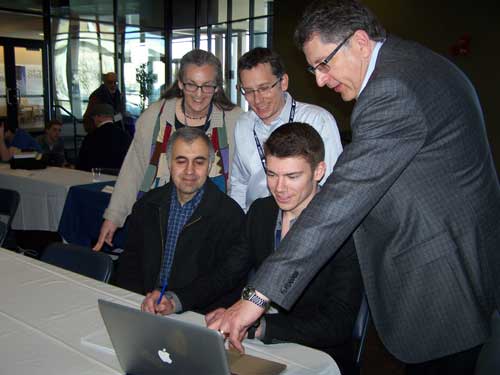The Following article was published about the Center for Entrepreneurship’s commercialization team recently launching the NSF I-Corps program at the University of Toledo, with more to come!
The University of Toledo was selected by the National Science Foundation as one of the first four sites in the nation to launch its Innovation Corps (I-Corps) Program for commercializing technology.
UT partnered with the University of Michigan to launch the first class of I-Corps program participants at UT this week (March 8-11). Faculty, students and mentors from both universities gathered to work in eight teams through the six-week I-Corps program.
“This is a unique and important opportunity for individuals to join a very select group of people who have been chosen to participate in this program,” said Jessica Sattler, director of Economic Engagement and Business Development Programs at UT.
The eight teams represent technologies in the areas of bio-engineering, chemistry and water technologies. One goal of the program is to catalyze teams whose technology concepts are likely candidates for commercialization.
Five teams from UT and three from UM will continue to make weekly online reports on their progress culminating in a two-day finale April 30 and May 1 at UT, Sattler said.
“We recruited faculty members and students with technologies that could be commercialized from UM and UT and paired each team with a mentor from the business community for two and a half days of intensive training and customer discovery,” said Patty Relue, professor of bioengineering at UT who served as co-site leader.
“They need to learn who is their customer and what value can they deliver to those customers by building the right product or service for the right customer,” said Jonathan Fay, her co-site leader from the Center for Entrepreneurship in the College of Engineering at UM.
The primary goal of NSF I-Corps is to foster entrepreneurship that will lead to the commercialization of technology that has been supported previously by NSF-funded research. The goals include using techniques developed to validate each commercial property in a recognized, effective way with customer and business model development.
The I-Corps program promotes a methodology in which entrepreneurs talk to their customers much earlier in the product and business development process. UM is one of seven I-Corps Nodes that serve as hubs for education, infrastructure and research, according to Fay.
I-Corps is a set of activities and programs that prepares scientists and engineers to extend their focus beyond the laboratory and broadens the impact of select NSF-funded, basic-research projects.
“It’s important for students to know how to translate the technology into business language,” said Tim Walker, a third-year mechanical engineering and pre-med student at UT from Ottawa Lake, Mich.
Walker was paired with Mohammad Elahinia, professor of mechanical engineering at UT, on a team that is developing new technology for blood clot removal. Viktor Brandtneris, an expert in customer discovery based business modeling from UM, served as their mentor and a teacher at the event.
“Faculty who spend so much time in the lab are learning a completely different set of skills used in business and industry,” Relue said.
“The main point of it is to educate and provide resources to these teams that enable them to talk to customers much earlier than is typical in the commercialization process, which allows them to truly understand and validate the market and their customers,” Sattler said.
The vehicle for commercialization activities will most often be start-ups founded by the I-Corps participants. Successful I-Corps projects will be prepared for business formation.
The purpose of the I-Corps teams is to identify NSF-funded researchers who will receive additional support in the form of mentoring and funding to accelerate innovation that can attract subsequent third-party funding.
I-Corps programs feed the NSF Small Business Innovation Research (SBIR) and Small Business Technology Transfer (STTR) programs nationally. NSF works with the private sector to bring additional resources to the table in the form of partnerships and finance when warranted.
Article ran March 11, 2015 in the Toledo Free Press
Photo Credit:
Toledo Free Press Photo by Duane Ramsey
Publication:
Toledo Free Press

